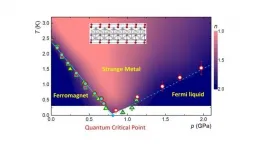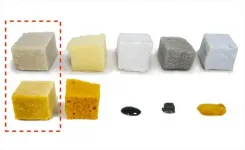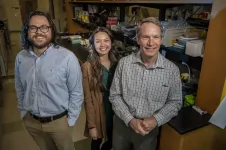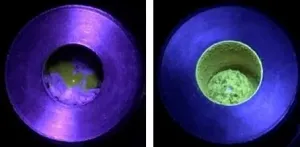Heavy fermion systems are metallic materials consisting of both a lattice of well-localized unpaired electrons (typically 4f or 5f electrons), together with a sea of conduction electrons. These are ideal for studying quantum critical points, since there is a delicate balance between magnetic interactions which lead to an ordered pattern of magnetic moments, and entanglement between the spins of the localized and conduction electrons, which quenches the magnetic moments. By applying pressure or magnetic fields to heavy fermion systems, experimenters can adjust the balance between these interactions, and hence they can suppress the transition to the magnetically ordered phase to lower temperatures, eventually reaching a zero-temperature quantum critical point.
Quantum critical points reached upon suppressing an antiferromagnetic transition have for many years been an important setting for exploring novel physics. This includes unusual phases of matter such as magnetic superconductivity, as well the breakdown of Fermi liquid behavior, meaning that the electronic excitations no longer correspond to those of a fluid of electrons, but instead there is a 'strange metal', where physical quantities such as the electrical resistivity and heat capacity exhibit an unusual temperature dependence. Such strange metal behavior is found in a few different classes of quantum materials, and is thought to be intimately linked to the high temperature superconductivity of the cuprate superconductors.
On the other hand, quantum critical points are not generally found upon suppressing a ferromagnetic transition, and they were theoretically predicted to not occur in clean disorder-free ferromagnetic materials. Instead, attempting to suppress the ferromagnetic transition either leads to the abrupt first-order disappearance of magnetic order, or a change of magnetic ground state. Recently, Prof. Yuan and his team at the Center for Correlated Matter, Zhejiang University have overturned this prevailing consensus by their discovery that the application of pressure can smoothly suppress ferromagnetic order in the clean heavy fermion system CeRh6Ge4 to zero temperature, reaching a ferromagnetic quantum critical point (B. Shen et al., Nature 579, 51 (2020)). They pressurized high-quality single crystals of CeRh6Ge4 and measured the electrical resistivity and heat capacity at very low temperatures down to 40mK, in order to track the fate of the ferromagnetic transition with pressure. Upon applying 0.8 GPa of pressure, it was found that the ferromagnetic transition is suppressed entirely, and instead a 'strange metal' phase is revealed, with a linear temperature dependence of the resistivity, and a logarithmic divergence of the specific heat coefficient (Fig.1), which are remarkably similar behaviors to those found in the cuprate superconductors.
In order to reveal the origin of this unexpected behavior, which was previously predicted to be impossible, a wide range of follow-up experimental studies were performed by researchers at the Center for Correlated Matter. Of particular importance is to characterize the electronic structure of CeRh6Ge4, which could address key issues such as whether the ferromagnetic quantum critical point in CeRh6Ge4 is an 'unconventional' local-type of quantum critical point accompanied by the delocalization of the Ce-4f electrons; does the spin-orbit coupling induced by broken inversion symmetry in the crystal lattice help give rise to the quantum critical behaviors; and what is the role played by the quasi-one-dimensional arrangement of Ce-chains in the crystal structure.
They first measured quantum oscillations of very high quality single crystals of CeRh6Ge4 for different directions of the applied magnetic field, and compared the results to those expected from calculations using density functional theory (Fig. 2). The results were published in Science Bulletin: An Wang, Feng Du, Yongjun Zhang, David Graf, Bin Shen, Ye Chen, Yang Liu, Michael Smidman, Chao Cao, Frank Steglich, Huiqiu Yuan*, Localized 4f-electrons in the quantum critical heavy fermion ferromagnet CeRh6Ge4, Science Bulletin, 2021, 66(14):1389-1394, DOI: 10.1016/j.scib.2021.03.006 https://www.sciencedirect.com/science/article/pii/S2095927321001833
This study revealed two important findings. The mean-free path of the CeRh6Ge4 crystals is extremely large, meaning that the scattering of the conduction electrons by defects or other sources of disorder is minimal. This demonstrates that their observation of the suppression of ferromagnetism by pressure was not induced by disorder, but is an intrinsic feature of pure CeRh6Ge4. Secondly, they found good agreement between their results and calculations of the band structure with fully localized Ce 4f-electrons, and poor agreement when the 4f-electrons were included and assumed to be itinerant. This shows that CeRh6Ge4 is distinct from previous examples of itinerant ferromagnets where quantum critical points are absent, suggesting that ferromagnetism with local moments is crucial for realizing ferromagnetic quantum critical points. Furthermore, these results are in line with expectations for local-type quantum criticality, but the smoking gun for this scenario would be the observation of a reconstruction of the electronic bands under pressure when CeRh6Ge4 is tuned through the quantum critical point.
At the same time, the momentum dependence of the electronic structure of CeRh6Ge4 was also probed using angle-resolved photoemission spectroscopy (ARPES), where the results were published in Physical Review Letters. Yi Wu, Yongjun Zhang, Feng Du, Bin Shen, Hao Zheng, Yuan Fang, Michael Smidman, Chao Cao, Frank Steglich, Huiqiu Yuan*, Jonathan D. Denlinger, Yang Liu*, Anistropic c-f hybridization in the ferromagnetic quantum critical metal CeRh6Ge4, Phys. Rev. Lett. 126, 216406 (2021), DOI: 10.1103/PhysRevLett.126.216406 https://doi.org/10.1103/PhysRevLett.126.216406.
Here they were able to examine the temperature dependence of the electronic state of the 4f electrons along different momentum directions. They found that the strength of the hybridization between the 4f and conduction electrons is highly anisotropic, and is much stronger parallel to the Ce chains than it is along perpendicular directions. Such direct evidence for anisotropic coupling is highly unusual in heavy fermion systems, and indicates that the one-dimensional arrangement of magnetic moments could also be a key ingredient for ferromagnetic quantum criticality.
INFORMATION:
It is clear that an understanding of the electronic structure, both in the ferromagnetic state and under pressure, is vital for understanding the mechanisms and conditions required to realize this new class of quantum materials. The significance of these results has been outlined by two renowned experts in the field of heavy fermion research Dr. Joe Thompson and Prof. Jon Lawrence, who have published a 'News & Views' article for Science Bulletin discussing these findings. Joe D. Thompson* and Jon M. Lawrence, Electrons matter in ferromagnetic criticality, Science Bulletin, 2021, 66(14):1369-1371, DOI: 10.1016/j.scib.2021.04.032
This work was supported by the National Key R&D Program, the National Natural Science Foundation, the Science Challenge Project and the Key R&D Program of Zhejiang Province in China. A portion of this work was supported by the National Science Foundation and the DOE in USA.






